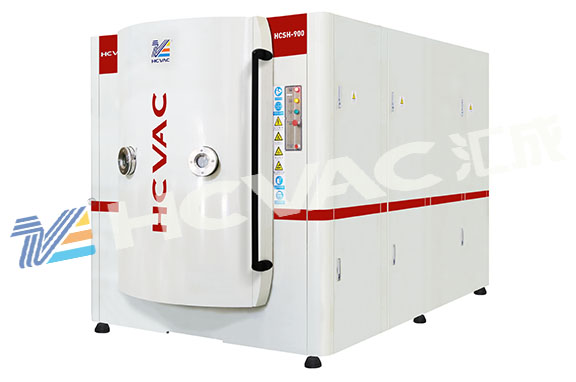Diamond-like carbon films have good mechanical properties, electrical properties, optical properties, extremely high hardness, resistivity, electrical insulation strength and thermal conductivity, high infrared transmittance and optical refractive index, as well as good chemical stability and biocompatibility property, so it has a wide range of applications. The number ratio of sp3 bonds to sp2 bonds in the film is the main factor that determines the hardness of the diamond-like film. The larger the value, the higher the hardness. Therefore, the diamond-like film has an adjustable high hardness, and its hardness The upper limit of the value is close to the hardness of diamond (100 GPa), reaching 95GPa. Hardness is related to DLC structure.

The DLC film prepared by the
DLC pvd coating machine using the magnetic filtration cathode arc method (FVCA) has a hardness similar to that of the diamond film; the hardness of the DLC film prepared by the vacuum cathode arc method (VCAD) is above HV5000; and the DLC film prepared by the magnetron sputtering method The film hardness is generally lower than HV2000. In addition, the deposition process and doping also have an impact on the hardness of the DLC film. Appropriate bias, pressure and atmosphere can improve the hardness of the DLC film to varying degrees. Most experiments show that doping makes DLC The hardness of the film decreases to varying degrees, but some people believe that the incorporation of Si can improve the hardness of the DLC film. There is generally a large internal stress in the DLC film. The internal stress is not only related to the structure and components of the DLC film, but also to The film formation process has a great relationship. For example, in H-DLC film, the internal stress has a great relationship with the H content.
While maintaining the high hardness of the DLC film, the incorporation of N, Si and certain metal elements can reduce the internal stress. The internal stress has a great impact on the bonding performance of the DLC film and the substrate. Directly depositing the DLC film on the substrate will improve the bonding of the film. The force is generally poor. The thinner the DLC film, the better the bonding force between the film and the substrate. In addition, the adhesion of the film can also be enhanced by adding a transition layer between the DLC film and the substrate. For example, using Cr as the transition layer will significantly Improved the bonding condition between the film and the substrate; different substrates have different transition layers. Because the DLC film has high hardness, it has excellent wear resistance, and its friction coefficient is low, so it is an excellent surface modification material. Because the DLC film has the above excellent properties, it has been widely used. DLC The film is very suitable for tool coating. The preparation process of DLC film has developed rapidly, and a variety of preparation methods have been developed. These methods are generally divided into two categories: physical vapor deposition (PVD for short) and chemical vapor deposition. (chemical vapor deposition referred to as CVD) and plasma enhanced chemical vapor deposition (PECVD).
The physical vapor deposition method of
pvd coating machine includes vacuum evaporation, resistance heating evaporation, induction heating evaporation, hot cathode ion plating, arc ion plating, active reactive ion plating, radio frequency ion plating, DC discharge ion plating, etc. Its outstanding feature is that it combines various A kind of gas discharge is introduced into the vapor deposition, so that the entire deposition process is carried out in the plasma, which greatly increases the particle energy. The film formation speed of ion plating is fast, the bonding force of the film base is good, and the film layer has good wrap-around properties, and can be used at lower temperatures. Deposition is performed at high temperature. The magnetic filter cathode vacuum arc deposition (FCVA) technology uses a magnetic filter coil to filter out large particles and neutral atoms generated by the arc source, so that almost all carbon ions reaching the substrate can be used at a higher deposition rate. A hydrogen-free DLC film has been prepared. Some people have used FCVA technology to make a hydrogen-free carbon film with an sp3 bond content of up to 90% and a hardness of up to 95 GPa. Its properties are similar to polycrystalline diamond materials. Sputtering plating uses glow discharge and cathode sputtering. The coating is carried out based on the sputtering principle. The magnetron sputtering method uses argon ions Ar to sputter the graphite target through DC intermediate frequency or radio frequency. The energy distribution of the sputtered carbon atoms varies depending on the energy and type of the sputtered ions. The method is The advantages are low deposition temperature, simple equipment, large deposition area, and the ability to deposit high-resistance films and insulating films. Chemical vapor deposition (CVD) method and plasma enhanced chemical vapor deposition (PECVD) method. Chemical vapor deposition is a chemical phase reaction growth method. Several compounds or elemental reaction gases are introduced into the reaction chamber and carried out at the gas-solid interface. Decomposition, desorption, and combination reactions generate a uniform solid film. The main methods of chemical vapor deposition include: high and low temperature chemical vapor deposition under normal pressure and low pressure, metal organic chemical vapor deposition (MOCVD), and plasma-assisted chemical vapor deposition (PVCD). ) and laser chemical vapor deposition (LCVD), etc. The most important one is plasma-assisted chemical vapor deposition.



